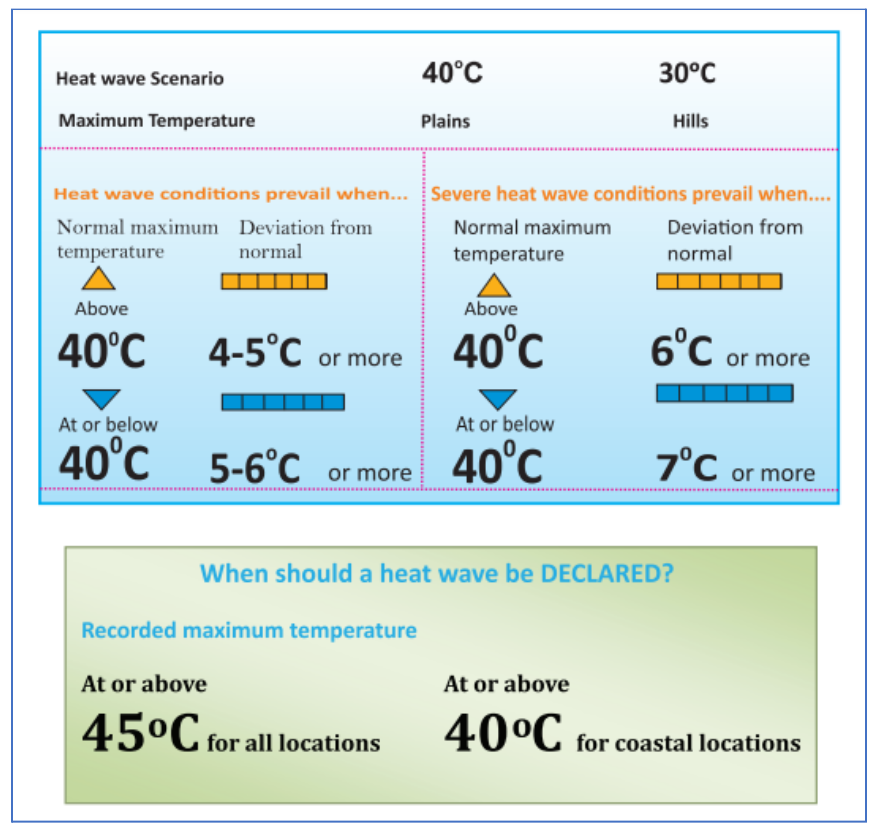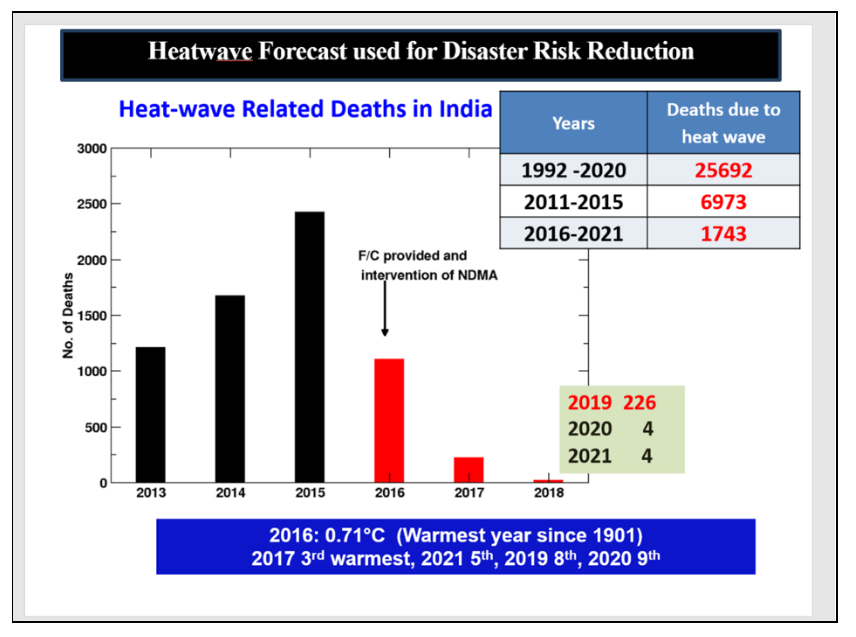Most parts of India are going through a severe heatwave as temperatures soar. Over the last decade, the instances of heatwave days have increased resulting in increased deaths. However, different agencies of the government like the IMD, NDMA, NCRB and WMO of the UN provide different data on mortality due to heatwaves.
This summer, record temperatures are being reported from different parts of the country. Heatwave warnings have been issued by the Indian Meteorological Department (IMD) since the second week of March itself whereas summer usually starts and peaks in the later months. According to the IMD’s monthly report for March 2022, the average maximum temperature recorded in March 2022 was the highest since 1901. In other words, this was the hottest March in the last 122 years for which data is maintained by IMD.
In March 2022, the average maximum, minimum and mean temperatures recorded at the national level were 33.10°C, 20.24°C, and 26.67°C respectively. Compared to the normal temperatures recorded for the same month in the period from 1980 to 2010, the average temperatures have gone up above normal by 1.86°C, 1.37°C, and 1.61°C respectively. The temperature in Central India even crossed 35°C while Northwest India recorded an increase of 3.9°C than the normal levels. The absence of active Western Disturbances which bring rain to northwestern and central parts of India in a non-monsoon season like winter and summer is one reason behind the high temperature.
In the month of April 2022, the temperatures recorded were in the range of 44 to 47°C in most parts of East Uttar Pradesh, Madhya Pradesh & Vidarbha. Temperatures of the range 42 to 45°C were recorded in most parts of west Rajasthan, Haryana, Delhi, and Telangana, and parts of Jharkhand, Gujarat, West Uttar Pradesh, Madhya Maharashtra, Punjab and in isolated pockets of Marathwada, Bihar & interior Gangetic West Bengal, Chhattisgarh, northern Odisha and Rayalaseema. IMD has been reported to have stated that April 2022 was the hottest April in the last 122 years for northwest and central India.
Heatwave is measured relative to usual weather and normal temperatures in a season
Envistats, by the Ministry of Statistics, defines a heatwave as “a prolonged period of excessive heat, often combined with excessive humidity”. Generally, heat waves are measured relative to the usual weather in the area and relative to normal temperatures for the season. It usually occurs in the months of March to June, in India. The Indian Meteorological Department (IMD) has defined the following criteria for Heat Waves:
- The maximum temperature of a station should reach at least 40°C for Plains and 30°C for Hilly regions for considering heatwave. If the normal maximum temperature of a station is less than or equal to 40°C, then an increase of 5°C to 6°C from the normal temperature is considered to be a heatwave condition. An increase of 7°C or more from the normal temperature is considered a severe heatwave condition.
- If the normal maximum temperature of a station is more than 40°C, then an increase of 4°C to 5°C from the normal temperature is a heatwave condition, and an increase of 6°C or more is considered a severe heatwave condition.
- If the actual maximum temperature remains 45°C or more irrespective of the normal maximum temperature, a heatwave is declared.
- For coastal areas, when the maximum temperature departure is 4.5°C or more from normal, or if the actual maximum temperature is 40°C or more.

The annual average number of heatwave days recorded across states has increased
In each decade since 1970, the annual average number of heatwave days in India recorded across states dropped from 99 days in 1970-1979 to 92 days in 1990-1999. This rose to 137 days during 2010-2019. A total of 42 and 36 heatwaves days have been recorded in 2020 and 2021, respectively. The annual average number of heatwave days across states in each decade also follows a similar trend. During 2010-2019, Rajasthan recorded the highest- 13 days, followed by Odisha (12), Jharkhand, and Andhra Pradesh. In 2020 and 2021, the number of days has been much lower.
More than 17,000 deaths have been reported due to heatwaves since 1970
According to Envistats 2022 which publishes data produced by the IMD, a total of 17,488 deaths due to heatwaves have been reported since 1970. While 1970-79 recorded over 2,488 deaths, it dropped to 1,505 in 1980-1989 and has been on a rise since. During 2010-2019, the number of deaths rose to 6,496, about 4.3 times the number during 1980-89. In the 2015 heatwave, close to 2,000 deaths were recorded, the majority from Andhra Pradesh and Telangana, where extremely high humidity, as well as extreme temperatures, was experienced. May 2015 witnessed temperatures that were 5.5°C above normal.
WMO has warned about rising temperatures in India and Pakistan
The World Meteorological Organization (WMO) has sounded a warning about the soaring temperatures recorded in India and Pakistan. Citing that both countries are rolling out health action plans to save lives, WMO stated that the unusual heat is consistent with what is expected of climate change. According to WMO, between 1992 and 2020 (in 28 years), 25,692 deaths occurred due to heatwaves in India. About one-third of the deaths took place between 2011 and 2021.

Data on deaths provided by Envistats, WMO, and NDMA does not match
The WMO’s data on deaths due to heatwave does not match with the data provided in Envistats of MoSPI. The MoSPI report claims that only two-thirds of the deaths (17000+) took place, that too in a period of 52 years from 1970 compared to the 25000+ deaths reported by the WMO between 1992 & 2020.
On the other hand, data from the National Disaster Management Authority (NDMA) shows that between 1992 and 2015, a total of 24,223 deaths were recorded across India due to heatwaves. NDMA also stated that only four deaths were reported in 2020 because of the lockdown measures. However, 27 deaths due to heatwave were recorded in 2020, and none in 2021 according to Envistats 2022.
According to the National Crime Records Bureau’s (NCRB) annual publication on Accidental deaths and suicides based on data furnished by state police departments and published in the Envistats, heatstroke/ sunstroke was recorded as the cause of death of 20,615 persons in the 22 years from 2000 to 2020. Even this data does not match with the IMD data provided in Envistats 2022. As per NCRB, the annual average number of deaths recorded between 2000 and 2004 was 664 which more than doubled to 1,307 between 2015-2019.
While it is possible that the difference in the data is due to the different ‘definition of death’ followed by a specific agency, such varied numbers affect the credibility of the data.
Mortality has increased over the years, though the exact number is still not clear
As noted earlier, different data sources give different statistics on fatalities in heatwaves. This calls for a standardized recording of data by the government adopting a similar definition across various agencies, considering the seriousness of the issue. Proper & credible data is necessary to keep track of the varying impact of heatwaves across different regions and to come up with required interventions to combat it. However, though the data maintained by IMD, NDMA, and NCRB give different numbers, a common trend is an increase in average mortality over the years, which indicates the increased effects of heatwaves.
The frequency, duration, and intensity of hot spells is very likely to rise
Climate change is causing an increase in global average temperatures. The International Panel on Climate Change in its latest report has highlighted that there will be an increase in extreme weather events in South Asia, including India. The frequency, duration and intensity of hot spells are very likely to rise by the end of the century. Studies also suggest an increase in the probability of mortality even with a moderate increase in mean temperatures.
Heatwaves have a significant impact on life, especially on vulnerable sections like construction workers, elderly persons, vendors, etc. The health of millions and productivity of labour is also severely impacted. Additionally, it directly affects agriculture production resulting in food security issues. Water availability, forest fires, and livelihoods, are also affected by heatwaves.
Heat also results in an increased demand for energy. The maximum all-India power demand met was recorded at 201.066 GW on 26 April 2022, as per the Ministry of Power.
Heat Action Plan is implemented by India
The Government of India adopted a Heat Action Plan in different States to tackle the impact of heatwaves since 2013. A Heat Action Plan is a comprehensive early warning system and preparedness plan for extreme heat events. IMD in collaboration with local health departments is preparing/implementing Heat Action Plan in many parts of the country. NDMA has also issued National Guidelines for Preparation of Action Plan- Prevention and Management of Heat Wave.
At an individual level, one can take simple precautions to reduce the effect of the heatwave.

Featured Image: Heatwave in India


